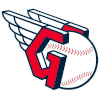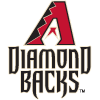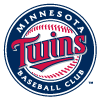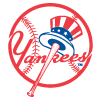This article is part of our MLB Barometer series.
Across all of my fantasy leagues, the category in which I tend to perform best is strikeouts. What's my secret? Trying to win strikeouts.
That probably sounds overly simplistic, as everyone is generally trying to do as well as possible in every category (unless you're punting steals or saves). With strikeouts, however, the effort is most likely to be rewarded. The following table shows the correlation between the top of the leaderboard from one season to the next in the four typical fantasy categories for starting pitchers (using strikeout rate rather than strikeouts for a fairer representation of a pitcher's abilities):
| Category | Players in top 10 in 2017 who were in the top 20 in 2016 | Players in top 10 in 2018 who were in the top 20 in 2017 | Players in top 10 in 2018 who were in the top 20 in 2018 |
|---|---|---|---|
| K Rate | 4 | 6 | 5 |
| WHIP | 3 | 6 | 4 |
| W | 3 |
Across all of my fantasy leagues, the category in which I tend to perform best is strikeouts. What's my secret? Trying to win strikeouts.
That probably sounds overly simplistic, as everyone is generally trying to do as well as possible in every category (unless you're punting steals or saves). With strikeouts, however, the effort is most likely to be rewarded. The following table shows the correlation between the top of the leaderboard from one season to the next in the four typical fantasy categories for starting pitchers (using strikeout rate rather than strikeouts for a fairer representation of a pitcher's abilities):
| Category | Players in top 10 in 2017 who were in the top 20 in 2016 | Players in top 10 in 2018 who were in the top 20 in 2017 | Players in top 10 in 2018 who were in the top 20 in 2018 |
|---|---|---|---|
| K Rate | 4 | 6 | 5 |
| WHIP | 3 | 6 | 4 |
| W | 3 | 4 | 2 |
| ERA | 2 | 4 | 2 |
One thing to note from that table is that consistency at the top of the pitcher leaderboards is hard to find in general, due primarily to the frequency and severity of pitcher injuries, which is one of the reasons why most fantasy owners spend roughly two thirds of their auction budgets on hitters. When looking for whatever scraps of consistency you can find, however, strikeouts certainly seem to be the most reliable (though WHIP comes in a closer second than I anticipated).
A pitcher who possesses strikeout stuff this season will probably be able to strike batters out next year, too. Pitchers exercise the most control over that category, as the only two people who really matter to a strikeout are the pitcher and the batter. WHIP involves the entirety of a team's defense as well. ERA adds in a team's relief pitching as another small factor. Wins are impacted by the team's offense and the opposing pitcher and include the strangest names on any of the leaderboards — Chris Tillman and Hisashi Iwakuma each won 16 games in 2016 and have combined for two wins since.
That's not to say that pitchers' strikeout rates can't change. All three pitchers who feature in this week's column have seen dramatic chances in their strikeout numbers this season. Since those changes are generally rare, however, they're also more meaningful and more likely to stick than changes in other categories.
RISERS
 Mike Clevinger, SP, Indians: Clevinger's season took a long time to get going, as he missed two months with a back injury and landed right back on the injured list with an ankle issue after just one start. In his three starts in July, however, he's been excellent, recording a 1.06 ERA, a 41.5 percent strikeout rate and a 4.6 percent walk rate. Even over his first four starts, when he struggled to a 5.89 ERA, his strikeout rate was excellent, coming in at 41.3 percent. As Clevinger was developing into an ace over the previous two seasons, he'd recorded a fairly strong 26.2 percent strikeout rate, but he's never been nearly this dominant in that category. He's significantly increased his fastball velocity, which now is 96.0 mph after coming in at 93.6 percent last season, so there's at least some reason to believe he can remain elite in that category. Clevinger could well be a true top-tier option the rest of the way.
Mike Clevinger, SP, Indians: Clevinger's season took a long time to get going, as he missed two months with a back injury and landed right back on the injured list with an ankle issue after just one start. In his three starts in July, however, he's been excellent, recording a 1.06 ERA, a 41.5 percent strikeout rate and a 4.6 percent walk rate. Even over his first four starts, when he struggled to a 5.89 ERA, his strikeout rate was excellent, coming in at 41.3 percent. As Clevinger was developing into an ace over the previous two seasons, he'd recorded a fairly strong 26.2 percent strikeout rate, but he's never been nearly this dominant in that category. He's significantly increased his fastball velocity, which now is 96.0 mph after coming in at 93.6 percent last season, so there's at least some reason to believe he can remain elite in that category. Clevinger could well be a true top-tier option the rest of the way.
 Sonny Gray, SP, Reds: Early in his career, Gray was one of the better pitchers in baseball, coming in third in AL Cy Young voting in his second full season back in 2015. Even during his era of dominance, however, his fantasy value was held back by the fact that his strikeout rate was only ever average at best. That made him a very unexciting option during this draft season, as his strikeout rate remained mediocre in recent years while his ERA ballooned to 4.90 or above in two of the last three seasons. Suddenly, in his first season in the National League, Gray is now a strikeout pitcher, with his 28.6 percent strikeout rate coming in six points above his previous full-season high. Combined with an increase in groundball rate to 55.5 percent, his highest since 2014, the rise in strikeouts has helped lower his ERA by a full run and a half to 3.40, a mark his FIP (3.36) and xFIP (3.37) support. The full package makes Gray as interesting of a fantasy option as he's ever been.
Sonny Gray, SP, Reds: Early in his career, Gray was one of the better pitchers in baseball, coming in third in AL Cy Young voting in his second full season back in 2015. Even during his era of dominance, however, his fantasy value was held back by the fact that his strikeout rate was only ever average at best. That made him a very unexciting option during this draft season, as his strikeout rate remained mediocre in recent years while his ERA ballooned to 4.90 or above in two of the last three seasons. Suddenly, in his first season in the National League, Gray is now a strikeout pitcher, with his 28.6 percent strikeout rate coming in six points above his previous full-season high. Combined with an increase in groundball rate to 55.5 percent, his highest since 2014, the rise in strikeouts has helped lower his ERA by a full run and a half to 3.40, a mark his FIP (3.36) and xFIP (3.37) support. The full package makes Gray as interesting of a fantasy option as he's ever been.
 Josh Donaldson, 3B, Braves: There were legitimate reasons to worry about Donaldson heading into this season, given his age (33) and the injuries which wrecked his 2018 campaign. He wasn't terrible to start the season, but his .237/.357/.419 line through his first 62 games was well below the high standards he'd set in previous years. He's turned things on since then, recording an excellent .288/.404/.696 line with 15 homers in 35 games. There are plenty of reasons to believe he can remain a top-tier hitter down the stretch. For one, it's easier to believe in excellence from a player who's been excellent before. Additionally, many of his Statcast numbers suggest he's hitting the ball as well as he did at his peak; his 15.7 percent barrel rate, 92.8 mph exit velocity and 50.0 percent hard-hit rate all represent Statcast era highs.
Josh Donaldson, 3B, Braves: There were legitimate reasons to worry about Donaldson heading into this season, given his age (33) and the injuries which wrecked his 2018 campaign. He wasn't terrible to start the season, but his .237/.357/.419 line through his first 62 games was well below the high standards he'd set in previous years. He's turned things on since then, recording an excellent .288/.404/.696 line with 15 homers in 35 games. There are plenty of reasons to believe he can remain a top-tier hitter down the stretch. For one, it's easier to believe in excellence from a player who's been excellent before. Additionally, many of his Statcast numbers suggest he's hitting the ball as well as he did at his peak; his 15.7 percent barrel rate, 92.8 mph exit velocity and 50.0 percent hard-hit rate all represent Statcast era highs.
 Ketel Marte, 2B/SS/OF, Diamondbacks: Marte's batting line sat at .250/.296/.483 at the end of April, an increase in power from his previous seasons but on the whole not particularly exciting. In the 67 games since, he's been a completely different player, hitting .351/.406/.620 with 15 homers and earning a well-deserved All-Star appearance. The home runs just in that stretch are a career high, and he'll need just seven more the rest of the way to double his career high. Still just 25, it's not terribly surprising to see Marte taking a step forward, but a jump of this magnitude was certainly unanticipated. His Statcast numbers largely support his breakout, however, as he has career highs in barrel rate (9.5 percent), exit velocity (89.9 mph), launch angle (11.7 degrees) and hard-hit rate (39.3 percent), so it shouldn't be a surprise to see him continue a similar performance down the stretch.
Ketel Marte, 2B/SS/OF, Diamondbacks: Marte's batting line sat at .250/.296/.483 at the end of April, an increase in power from his previous seasons but on the whole not particularly exciting. In the 67 games since, he's been a completely different player, hitting .351/.406/.620 with 15 homers and earning a well-deserved All-Star appearance. The home runs just in that stretch are a career high, and he'll need just seven more the rest of the way to double his career high. Still just 25, it's not terribly surprising to see Marte taking a step forward, but a jump of this magnitude was certainly unanticipated. His Statcast numbers largely support his breakout, however, as he has career highs in barrel rate (9.5 percent), exit velocity (89.9 mph), launch angle (11.7 degrees) and hard-hit rate (39.3 percent), so it shouldn't be a surprise to see him continue a similar performance down the stretch.
 Jeimer Candelario, 3B, Tigers: Candelario was always supposed to be a pretty good hitter, showcasing above-average contact along with average power. He hadn't shown much early in his career, however, hitting .223/.315/.371 in 952 plate appearances through June 1. Since returning from Triple-A Toledo in late June, though, he's been an entirely different hitter, posting a .301/.370/.589 line with five homers in 20 games. His hard-hit rate spiked from 33.6 percent over the first stretch of his career to an impressive 56.4 percent over his last 20 games. A jump that large is probably not sustainable, but Candelario finally looks to be showing something and should be at least an interesting deep-league option the rest of the way.
Jeimer Candelario, 3B, Tigers: Candelario was always supposed to be a pretty good hitter, showcasing above-average contact along with average power. He hadn't shown much early in his career, however, hitting .223/.315/.371 in 952 plate appearances through June 1. Since returning from Triple-A Toledo in late June, though, he's been an entirely different hitter, posting a .301/.370/.589 line with five homers in 20 games. His hard-hit rate spiked from 33.6 percent over the first stretch of his career to an impressive 56.4 percent over his last 20 games. A jump that large is probably not sustainable, but Candelario finally looks to be showing something and should be at least an interesting deep-league option the rest of the way.
 Travis d'Arnaud, C, Rays: The Mets gave d'Arnaud less than a month to show what he could do following Tommy John surgery, designating him for assignment in late April after just 25 plate appearances. He eventually found his way to Tampa Bay, where he's now started 11 of the last 16 games. He's been so good for the Rays, hitting .262/.319/.517 in 43 games over and .340/.400/.740 over his last 14 games, that they've started playing him at first base to keep his bat in the lineup. D'Arnaud hit .268/.340/.485 in 67 games for the Mets back in 2015, so this level of offense isn't completely unprecedented, but he hadn't posted an above-average line since, so to see him break out like this at age 30 is quite a surprise. With personal Statcast-era highs (not counting his four-game 2018 campaign) in barrel rate (9.3 percent), exit velocity (90.2 mph) and hard-hit rate (42.6 percent), though, his improved performance looks fairly sustainable. The Rays are one of the smarter organizations, so it's believable that they could have unlocked something in the veteran, making him a solid catching option the rest of the season.
Travis d'Arnaud, C, Rays: The Mets gave d'Arnaud less than a month to show what he could do following Tommy John surgery, designating him for assignment in late April after just 25 plate appearances. He eventually found his way to Tampa Bay, where he's now started 11 of the last 16 games. He's been so good for the Rays, hitting .262/.319/.517 in 43 games over and .340/.400/.740 over his last 14 games, that they've started playing him at first base to keep his bat in the lineup. D'Arnaud hit .268/.340/.485 in 67 games for the Mets back in 2015, so this level of offense isn't completely unprecedented, but he hadn't posted an above-average line since, so to see him break out like this at age 30 is quite a surprise. With personal Statcast-era highs (not counting his four-game 2018 campaign) in barrel rate (9.3 percent), exit velocity (90.2 mph) and hard-hit rate (42.6 percent), though, his improved performance looks fairly sustainable. The Rays are one of the smarter organizations, so it's believable that they could have unlocked something in the veteran, making him a solid catching option the rest of the season.
FALLERS
 Jorge Polanco, SS, Twins: Polanco started the season on a tear, hitting .338/.397/.569 through his first 64 games entering at least the fringe of the early MVP conversation. In the 29 games since, however, he's come crashing back to earth, hitting .238/.296/.362. The big drop in power can be traced at least in part to a drop in his flyball rate, which sat at 49.3 percent during his good stretch and 41.7 percent during his poor one. A drop in BABIP from .370 to .264 certainly didn't help, either. The 26-year-old's career .281/.338/.441 slash line comes in roughly halfway between those two performances and probably best represents what we should expect from Polanco the rest of the way: a competent hitter, but not someone who can carry an offense.
Jorge Polanco, SS, Twins: Polanco started the season on a tear, hitting .338/.397/.569 through his first 64 games entering at least the fringe of the early MVP conversation. In the 29 games since, however, he's come crashing back to earth, hitting .238/.296/.362. The big drop in power can be traced at least in part to a drop in his flyball rate, which sat at 49.3 percent during his good stretch and 41.7 percent during his poor one. A drop in BABIP from .370 to .264 certainly didn't help, either. The 26-year-old's career .281/.338/.441 slash line comes in roughly halfway between those two performances and probably best represents what we should expect from Polanco the rest of the way: a competent hitter, but not someone who can carry an offense.
 Gary Sanchez, C, Yankees: Despite hitting 18 homers in just 89 games last season, Sanchez was generally a disappointment at the plate, managing an unimpressive .186/.291/.406 slash line. He looked to be back as the best offensive catcher through his first 42 games this season, however, hitting .270/.345/.660 with 19 homers. His batting-average struggles have since returned, unfortunately, as he's slumped to a .195/.262/.359 line in his last 33 games. Interestingly, his strikeout rate has remained at an identical 27.7 percent over both parts of this season, a career high but seemingly not the primary culprit. His batted-ball profile changed dramatically for the worse between those two stretches, however. Early in the season, he recorded a 56.0 percent flyball rate, a 52.3 percent pull rate and a 50.5 percent hard-hit rate; those numbers have fallen to 37.8 percent, 46.7 percent and 40.0 percent, respectively, over his last 33 games. Sanchez's early season dominance is a useful reminder of the highs he can reach, but he remains a streaky hitter.
Gary Sanchez, C, Yankees: Despite hitting 18 homers in just 89 games last season, Sanchez was generally a disappointment at the plate, managing an unimpressive .186/.291/.406 slash line. He looked to be back as the best offensive catcher through his first 42 games this season, however, hitting .270/.345/.660 with 19 homers. His batting-average struggles have since returned, unfortunately, as he's slumped to a .195/.262/.359 line in his last 33 games. Interestingly, his strikeout rate has remained at an identical 27.7 percent over both parts of this season, a career high but seemingly not the primary culprit. His batted-ball profile changed dramatically for the worse between those two stretches, however. Early in the season, he recorded a 56.0 percent flyball rate, a 52.3 percent pull rate and a 50.5 percent hard-hit rate; those numbers have fallen to 37.8 percent, 46.7 percent and 40.0 percent, respectively, over his last 33 games. Sanchez's early season dominance is a useful reminder of the highs he can reach, but he remains a streaky hitter.
 Nomar Mazara, OF, Rangers: Mazara has been expected to take the next step for a while now. He's showed up as a promising bat according to the projection systems for the last few years, because even holding your own at age 21 as he did back in 2016 typically bodes well for the future. He hasn't really progressed since posting a 91 wRC+ that season, however, recording an 89 wRC+ in 2017, a 96 wRC+ last season and now an 86 wRC+ this year. He's been particularly poor over his last 17 games, hitting .150/.221/.267. Mazara's strikeout and walk rates have each moved in the wrong direction by about a point and a half this season, and while there's at least some room for encouragement in the form of a career-high barrel rate (11.0 percent), the overall picture certainly doesn't suggest that the long-anticipated breakout is imminent.
Nomar Mazara, OF, Rangers: Mazara has been expected to take the next step for a while now. He's showed up as a promising bat according to the projection systems for the last few years, because even holding your own at age 21 as he did back in 2016 typically bodes well for the future. He hasn't really progressed since posting a 91 wRC+ that season, however, recording an 89 wRC+ in 2017, a 96 wRC+ last season and now an 86 wRC+ this year. He's been particularly poor over his last 17 games, hitting .150/.221/.267. Mazara's strikeout and walk rates have each moved in the wrong direction by about a point and a half this season, and while there's at least some room for encouragement in the form of a career-high barrel rate (11.0 percent), the overall picture certainly doesn't suggest that the long-anticipated breakout is imminent.
 Nick Pivetta, SP, Phillies: Pivetta featured in this column in mid-April after an awful start to the season saw him get sent to the minors. He featured again in mid-June after returning to the big leagues for three strong starts, as he looked to have the chance to produce in line with his high draft-season expectations the rest of the way. Since that article, he's been back to being bad, posting a 6.61 ERA in 32.2 innings and getting sent to the bullpen in favor of Drew Smyly, whose ERA was 8.42 before the Phillies picked him up off the scrap heap. The interesting and worrying thing about Pivetta's latest struggles is that he's been bad in a new way. Always a high-strikeout pitcher whose ERAs were inflated by the long ball, he's managed a poor 14.7 percent strikeout rate over his latest poor stretch, dragging his season mark down to 18.7 percent, well off the strong 27.1 percent strikeout rate he managed last season. There's little reason to be interested in the Canadian at the moment, even if he returns to the rotation soon.
Nick Pivetta, SP, Phillies: Pivetta featured in this column in mid-April after an awful start to the season saw him get sent to the minors. He featured again in mid-June after returning to the big leagues for three strong starts, as he looked to have the chance to produce in line with his high draft-season expectations the rest of the way. Since that article, he's been back to being bad, posting a 6.61 ERA in 32.2 innings and getting sent to the bullpen in favor of Drew Smyly, whose ERA was 8.42 before the Phillies picked him up off the scrap heap. The interesting and worrying thing about Pivetta's latest struggles is that he's been bad in a new way. Always a high-strikeout pitcher whose ERAs were inflated by the long ball, he's managed a poor 14.7 percent strikeout rate over his latest poor stretch, dragging his season mark down to 18.7 percent, well off the strong 27.1 percent strikeout rate he managed last season. There's little reason to be interested in the Canadian at the moment, even if he returns to the rotation soon.










